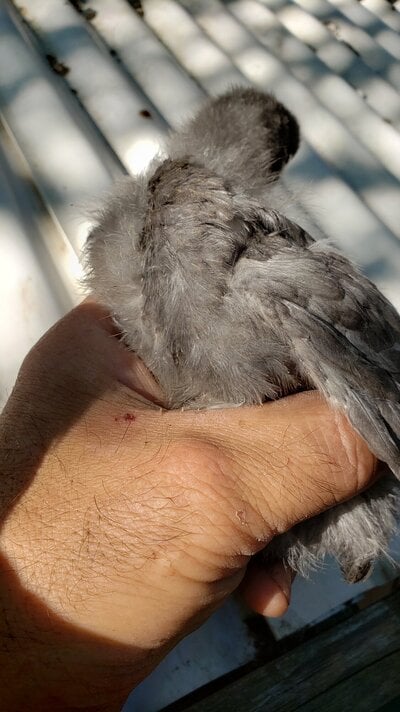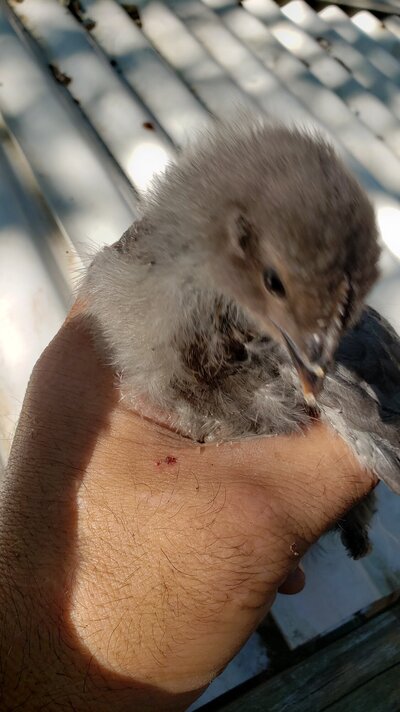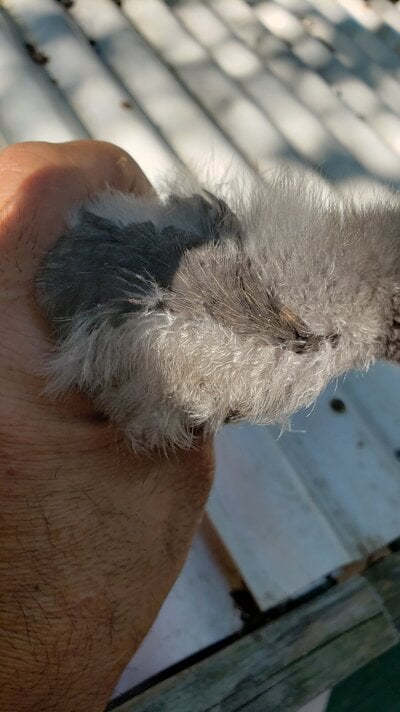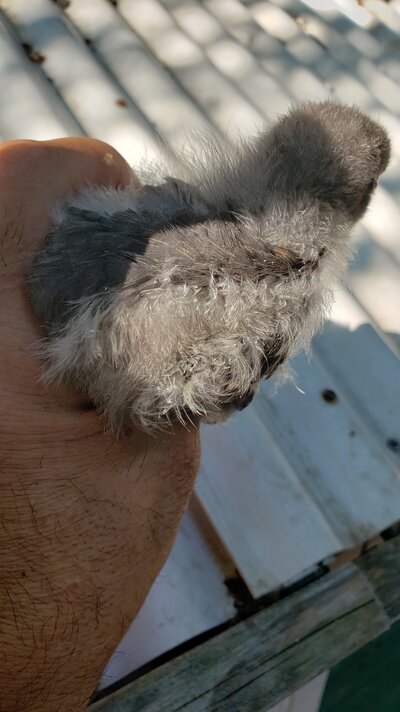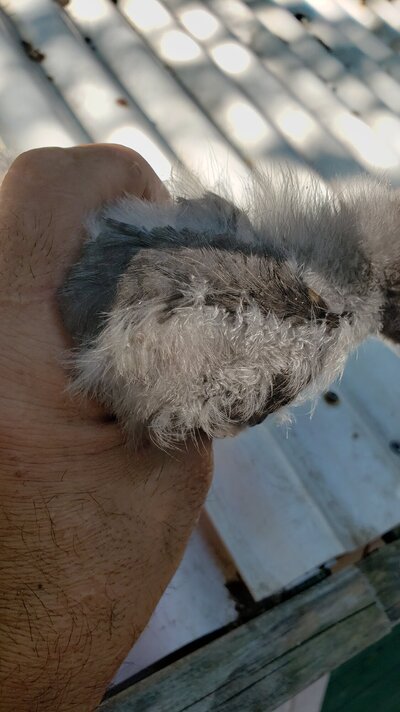I'm very unsure of what you're arguing with me about. I am simply stating the following: all chicks from a lavender father and any of your possible mothers would be black. This also applies to chick down. If you do not trust me, look at the genetics calculator:
 Your other rooster is blue barred. That means 25% of offspring are single copy barred, 25% black, 25% single copy blue barred, and 25% are blue. I know you are adamant that chick down does not correlate to adult color, but in fact it does. The grey chicks are not black, they are blue meaning they at the very least do not have the lavender father. If the Faverolles is certainly the mother, then you can be absolutely certain the Sapphire Gem is the father. Chick down is a great tool for figuring out the E locus bases in chicks and chick down does correlate to adult color. Yes, mixed breeds with uncertain genetics can make guessing more difficult but it's still an extremely valuable tool!
Your other rooster is blue barred. That means 25% of offspring are single copy barred, 25% black, 25% single copy blue barred, and 25% are blue. I know you are adamant that chick down does not correlate to adult color, but in fact it does. The grey chicks are not black, they are blue meaning they at the very least do not have the lavender father. If the Faverolles is certainly the mother, then you can be absolutely certain the Sapphire Gem is the father. Chick down is a great tool for figuring out the E locus bases in chicks and chick down does correlate to adult color. Yes, mixed breeds with uncertain genetics can make guessing more difficult but it's still an extremely valuable tool!
Navigation
Install the app
How to install the app on iOS
Follow along with the video below to see how to install our site as a web app on your home screen.
Note: This feature may not be available in some browsers.
More options
You are using an out of date browser. It may not display this or other websites correctly.
You should upgrade or use an alternative browser.
You should upgrade or use an alternative browser.
Lavender Orpington x Faverolles
- Thread starter roonster
- Start date
- Thread starter
- #12
- Jun 20, 2016
- 178
- 199
- 181
I'm telling you something that I KNOW and you are saying "are you sure". I'm saying "yes" and now you say that I'm arguing.
Look the mothers are Faverolles. I am not going to repeat it. if you think thats arguing. fine
The gray have muffs and are 1/2 Faverolles. Now, you might know more about how Faverolles were created or if the hatchery is not pure? These things could be? ...but one thing is certain! The mothers are Faverolles from Tractor supply.

Look the mothers are Faverolles. I am not going to repeat it. if you think thats arguing. fine
The gray have muffs and are 1/2 Faverolles. Now, you might know more about how Faverolles were created or if the hatchery is not pure? These things could be? ...but one thing is certain! The mothers are Faverolles from Tractor supply.
- Thread starter
- #13
- Jun 20, 2016
- 178
- 199
- 181
I could see "salmon color" peaking thru from the start but its now clear enough to see in a pic.
It might turn out to be an interesting genetics project. Much of my Faverolles "down" is lavender. Under the salmon color it is lavender, so maybe I'll discover something new?
(i also attached the prior posted pic of one of my Faverolles hens, u can see the lavender peaking thru on her back).







It might turn out to be an interesting genetics project. Much of my Faverolles "down" is lavender. Under the salmon color it is lavender, so maybe I'll discover something new?
(i also attached the prior posted pic of one of my Faverolles hens, u can see the lavender peaking thru on her back).
Attachments
- Thread starter
- #14
- Jun 20, 2016
- 178
- 199
- 181
Growing up and looking pretty!
I'd say two hens from my Lavender roo, and rooster from my Blue Plymouth (or whatever he is)?




I'd say two hens from my Lavender roo, and rooster from my Blue Plymouth (or whatever he is)?
Bellaterraonline
Chirping
So a lavender orpington roo mixed with salmon Faverolle hen would make all black chicks?Are you sure they're part Faverolles? Lavender requires two copies of the gene to express itself. All chicks of the lavender father would be splits and thus just simply be black chicks. The lighter chicks are blue not lavender. Blue is expressed with one copy of the gene, splash with two unlike lavender
YesSo a lavender orpington roo mixed with salmon Faverolle hen would make all black chicks?
 They would be split for lavender however. This means that their offspring could express lavender when crossed with a lavender bird or a bird who is also split for lavender
They would be split for lavender however. This means that their offspring could express lavender when crossed with a lavender bird or a bird who is also split for lavender 
No birds shown are lavender. All are blue or black (minus the duckwing one).Growing up and looking pretty!
I'd say two hens from my Lavender roo, and rooster from my Blue Plymouth (or whatever he is)?View attachment 3252018View attachment 3252019View attachment 3252020View attachment 3252021
None of the offspring pictured here are Lavender. They are Blue. The Lavender Orpington is not the father. The one black bird with muffs/beard could be from a Faverolles. The other hens don't appear to have Faverolles in them, as they are clean legged. I'd be shocked that none of them have feathered feet.I could see "salmon color" peaking thru from the start but its now clear enough to see in a pic.
It might turn out to be an interesting genetics project. Much of my Faverolles "down" is lavender. Under the salmon color it is lavender, so maybe I'll discover something new?
(i also attached the prior posted pic of one of my Faverolles hens, u can see the lavender peaking thru on her back).View attachment 3185287View attachment 3185288View attachment 3185289View attachment 3185290View attachment 3185291View attachment 3185292View attachment 3185293
Snugglesandwigglespetcare
Songster
- Mar 25, 2023
- 124
- 106
- 126
I agree that all are blue or black. I have LO and just hatched chicks from my LO rooster. All black.No birds shown are lavender. All are blue or black (minus the duckwing one).
- Apr 7, 2022
- 1,009
- 923
- 241
Those birds are BLUE 1000% and not lavender in the slightest. I agree with a previous poster on the sire of these chicks. If they are the only two roosters in you had your lavender Orpington is NOT the father of the birds in this photo. Those birds are not lavender. Lavender requires two copies to express. Meaning both parents must both be lavender themselves or black carrying the lavender gene recessively. If you look at the plumage on the above birds, they have lacing/edging that only happens with blue, not lavender. Hope this helpsGrowing up and looking pretty!
I'd say two hens from my Lavender roo, and rooster from my Blue Plymouth (or whatever he is)?View attachment 3252018View attachment 3252019View attachment 3252020View attachment 3252021
New posts New threads Active threads
-
Latest posts
-
-
-
Dreaming of Spring Gardening in the Middle of a Wisconsin winter part 2
- Latest: Callender Girl
-
-
Latest threads
-
Older hen with breathing/respiratory issues. At a loss
- Started by twocayugas
- Replies: 2
-
Help! Sick Guinea fowel with dark green poop!
- Started by Insane poultry mama
- Replies: 0
-
What is the best way to peel off loose paint from a driveway?
- Started by bobsmith2002
- Replies: 2
-
Duck with infected toe nail
- Started by Reedw1
- Replies: 0
-
-
-
Threads with more replies in the last 15 days
-
-
Question of the Day - Thursday, August 14th, 2025
- Started by casportpony
- Replies: 75
-
-
-
-
×



